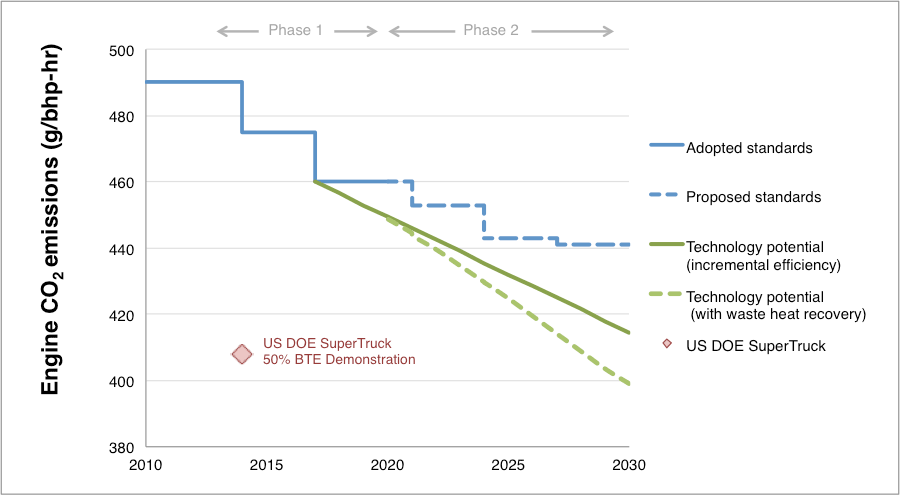Blog
The ever-improving efficiency of the diesel engine
Rudolf Diesel in the 1880s said, “The automobile engine will come, and then I will consider my life’s work complete.” He clearly knew how big a deal his invention was. But whatever judgment should be made about Diesel’s life’s work, the diesel engine itself was far from complete. For one thing, his earliest engines were only about 26% efficient. But that was a long, long time ago.
The potential efficiency of the diesel engine is hot topic in 2015, over a century later. This is because the U.S. EPA and NHTSA are assessing the potential stringency of new efficiency regulations for diesel engines as part of the “Phase 2” heavy-duty vehicle proposal. The federal agencies have the authority to regulate the heavy-duty vehicle engines to achieve the maximum feasible improvement and adopt technology-forcing standards, giving appropriate consideration to the cost of compliance, technology lead time, and other considerations.
Modern compression-ignition diesel engines dominate the commercial trucking industry with efficient engines that convert about 43%–44% of fuel energy into engine work, based on 2013–2014 certified engines. To meet the existing efficiency and carbon regulations, tractor engines will likely reduce their fuel use and CO2 emissions by 6% from 2010 to 2017, or roughly 1% per year. The question of the moment is how much more efficient diesel engines will get in the next phase of the regulations, from 2017 through the 2024–2027 timeframe.
In the June EPA/NHTSA proposal, diesel engines would reduce their fuel consumption and CO2 emissions per unit work by 4.2% from 2017 through 2027. The final standards would likely remain in effect for three additional years, so the standards would apply until 2029 or 2030. This would mean engine CO2 emissions would be reduced by an average of 0.3% to 0.4% per year through 2030. How does this compare to other numbers out there?
- The highest-volume tractor engine manufacturer, Cummins, indicates that engines can achieve a 9%–15% fuel use reduction from 2017, within the 2020–2030 timeframe.
- An engine analysis with West Virginia University (WVU) researchers indicates that tractor-trailer diesel engines can improve by over 10% from a 2017 baseline in the 2020-and-beyond timeframe.
- Work by the Southwest Research Institute for NHTSA indicates that diesel tractor engines can see reduced fuel consumption of 4%–7%—and up to 8%–10% with waste heat recovery—from a 2019 baseline within the Phase 2 timeframe.
- Teams led by Cummins, Daimler, Navistar, and Volvo demonstrated engine improvements of 12%–17% from a 2010 baseline. These U.S. DOE SuperTruck teams, as a result, are achieving approximately 50%–51% peak brake thermal efficiency.
- The SuperTruck programs follow-on goal would go further, with a brake thermal efficiency of 55% in peak conditions.
One can’t help but wonder what Rudolf Diesel would have thought, to know that the latest diesel innovations might be able to double the efficiency of his first diesel designs?
The figure below illustrates the existing 2014–2018 standards, the proposed 2017–2027 standards, and the technology potential from increased deployment of technology based on the above-mentioned WVU study in grams CO2 per brake-horsepower-hour. The technology potential in the figure suggests that tractor engines could achieve up to 7% improvement from incremental efficiency technology with the penetration of the WVU studies’ “2020+” engine package (i.e., from improvements from friction reduction, parasitics, turbocharging, aftertreatment, combustion optimization, and advanced controls). This potential from these incremental technologies is about double what the agencies included in the proposed rule for 2027.
In addition, we consider increased penetration of advanced engine technologies in the analysis in the figure. With greater penetration of the incremental 2020+ technologies and 15% penetration of organic Rankine cycle waste heat recovery (WHR) system (as assumed by the agencies), a fleet-wide CO2 improvement of up to 10% in 2027 is feasible. With greater penetration of WHR and U.S. DOE SuperTruck technologies, the technology potential is higher still. The results indicate that substantially lower CO2 emissions than the proposed EPA-NHTSA standard levels are technically achievable in the 2025 timeframe. The ultimate fleet-wide technology potential could reasonably meet the efficiency of the 2014–2016 US DOE SuperTruck demonstrations in the 2030 timeframe.

US Phase 1 (2014–2017) and proposed Phase 2 (2018–2030) regulatory standards, technology potential, technology potential with increased waste heat recovery (WHR), and U.S. DOE SuperTruck demonstrations.
The pending U.S. decision on the engines standards could be the only real action to substantially improve the efficiency of diesel engines for the next 10–15 years. For that reason, a strong case can be made that they should push the technology envelope as hard as is feasible based on emerging efficiency technologies. And the decision has broader implications for global innovation, as the same companies sell the same engines everywhere. India is also considering engine efficiency standards for its heavy-duty engines. The same high-efficiency engines could power the diesel-fueled trucks in China, Europe, Mexico, and elsewhere if these regions follow suit with similar, increasingly stringent regulations.
